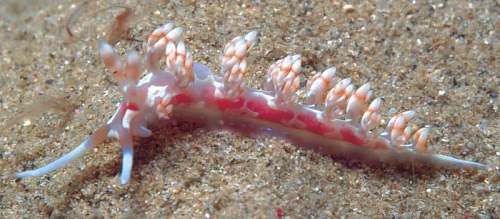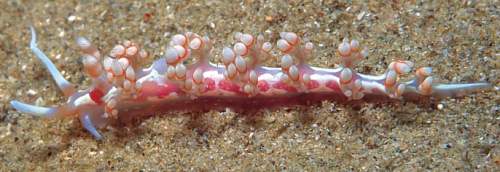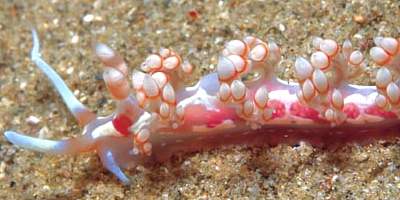Flabellina engeli from Tobago
August 16, 2003
From: Solomon Baksh


Dear Bill,
Concerning your comments on my earlier message. Sorry for the mix up in photos, this is the one. This image is the one that Eric Riesch from www.fishid.com said looks close to the Blue Streak Nudibranch. This is his reply:
"Thanks for the email. The photo of the 'Blue-Streak Nudibranch' in Humann & Deloach's (2002) Reef Creature Identification book is mine. Unfortunately this is an undescribed species. At this time there are no taxonomic biologists working on the order of nudibranchia in the Western Atlantic, therefore we cannot establish was this species is. I will hold onto your photo in case Paul Humann gets any word of a new marine biologist that is willing to work on these species IDs. Your photo seems to be a different species, but quite closely related to the one I photographed in Dominica. My specimen was also found in 10 feet of water in a rocky shoreline/ grassbed habitat. Thanks for your inquiry, sorry we could not be of more help - Eric Riesch, New World Publications"
Here are some details about my animal:
Location: Tobago, West Indies
Size: 1.5 cm
Depth: 1.5 m
There were several of these nudibranch crawling on the sand. The only noticable difference between this species and the 'blue-streak nudibranch' is the lack of the blue and black colour at the base. Hope you can help identify it.
Many thanks,
Solomon Baksh
chromis@tstt.net.tt
Baksh, S., 2003 (Aug 16) Flabellina engeli from Tobago. [Message in] Sea Slug Forum. Australian Museum, Sydney. Available from http://www.seaslugforum.net/find/10753
Dear Solomon,
This is Flabellina engeli. There are very few records of this species as well, but from those we can say that this species has a number of characteristic external features. These include the swollen lamellate rhinophores, the orange subterminal band on the cerata, and the opaque white bands between the ceratal groups on each side. Some animals are described as having orange or reddish patches on each side but from your photos, this colouration seems to be from the colour of the viscera showing through the transparent body wall. I would suggest this aspect of its colour pattern is dependent on the age of the animal, what it has recently been eating and the stage of development of its gonads.
Concerning the 'blue streak nudibranch' - the major difference I can make out in the photo in Humann & Deloach (2002) is that it has a single median white streak on the head, while F. engeli has a streak on each side of the head. I can't see the blue and black colouration.
Best wishes,
Bill Rudman
Related messages
-
New records from Brazil [3]
From: Vinicius Padula, August 23, 2007 -
Re: Flabellina engeli from Brazil
From: Vinicius Padula, January 11, 2007 -
Flabellina engeli from Brazil
From: Armando de Luca Jr, January 10, 2007 -
Re: Flabellina engeli from Tobago
From: Patrick Weir, January 27, 2006 -
South Florida aeolid is Flabellina engeli
From: Linda Ianniello, October 10, 2001 -
Aeolid from South Florida
From: Linda Ianniello , October 5, 2001
